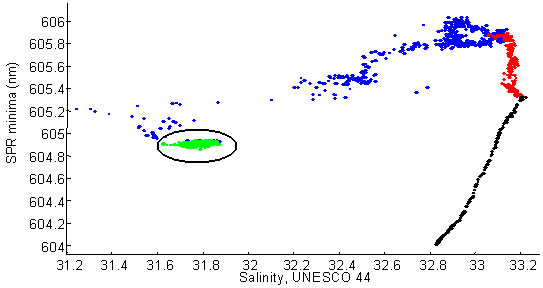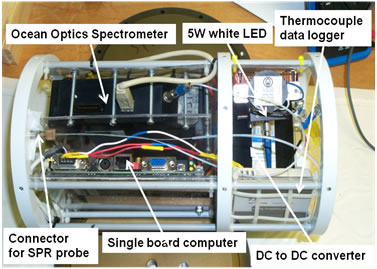Environmental Sensing
Our interest in environmental sensing is to develop small field portable instrumentation that can accurately track analytes of interest. Philosophically, we're translating the large body of work in industrial process analysis and applying to the environment. After all, most environmental features of interest are really just large flow-through reactors where we have little rational control of the inputs.
Current projects of interest are:
Sensor arrays for characterization of watersheds. We have recently shown the utility of surface plasmon resonance sensors to monitor salinity. Excitation emission matrix fluorescence is increasingly used to characterize unit material. We are building a field portable fiber-optic excitation emission matrix, and are for rapid screening of dissolved organic material. Combining the EEM fluorometer with the SPR sensor, conductivity measurements, dissolved oxygen and other inexpensive sensors such as optical light scattering, pH, and ion selective electrodes in a single field portable analyzer would enable rapid screening and mapping of coastal and riverine waterways.

Correlation plot of measured salinities and temperature corrected SPR minima presents four distinct classes of data with different trends: (Green) Prior to the ocean water – riverine water transition at the mouth of the Strait of Juan de Fuca; (Blue) At the ocean water – riverine water transition at the mouth of the Strait of Juan de Fuca;(Red) Traveling along the Strait of Juan de Fuca;(Black) Transitioning to fresh water in the Lake Washington ship canal.
Sensors for monitoring deep-sea hydrothermal vents. We have previously designed optical sensors for studying the chemistry in and around hydrothermal vents. In addition to designing the next generation of the sensors with greater sensitivity and reliability we are working on methods to employ the redox potential between the reducing vent fluid and the oxidizing ocean water as a battery to power the sensors for prolonged field deployment.
 SPR spectrometer designed for monitoring in and around deep sea hydrothermal vents.
SPR spectrometer designed for monitoring in and around deep sea hydrothermal vents.
Fiber optic Excitation-Emission Matrix fluorometer designed for monitoring in and around deep sea hydrothermal vents.
Deployment by Alvin's robotic arm at a diffuse flow hydrothermal vent 2 km below the ocean surface.
Chemically responsive polymers to environmental analytes. We're incorporating polymers that change molecular orientation following reversible association with target analytes. Usually these are hydrogel polymers that are imbued with analyte selectivity through molecular imprinting or judicious choice of functional groups and copolymer blocks. These polymer transduction layers are applied to determination of pesticides in groundwater and determination of vapor phase amines from feedlots.
Detection of vapor phase ammonia with a gold nanoparticle imbedded polyallylamine coating on the SPR sensor (left) inmproves the limit of detection 100x compared to a bare sensor. But using a polyelectrolyte multilayer of three repeating layers of polystyrenesulfonate / polyallylamine before adding a layer of gold nanoparticles yield an additional 10x improvement.
